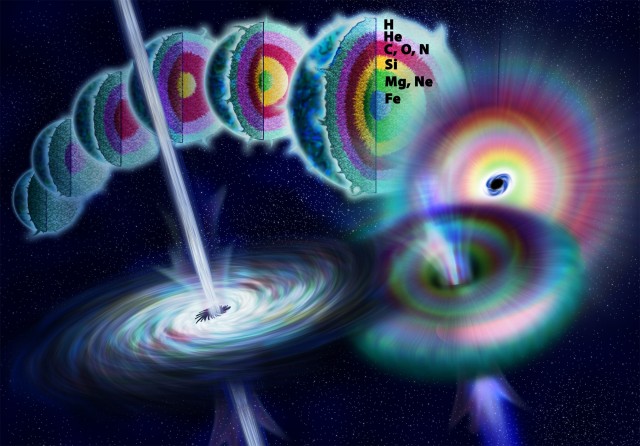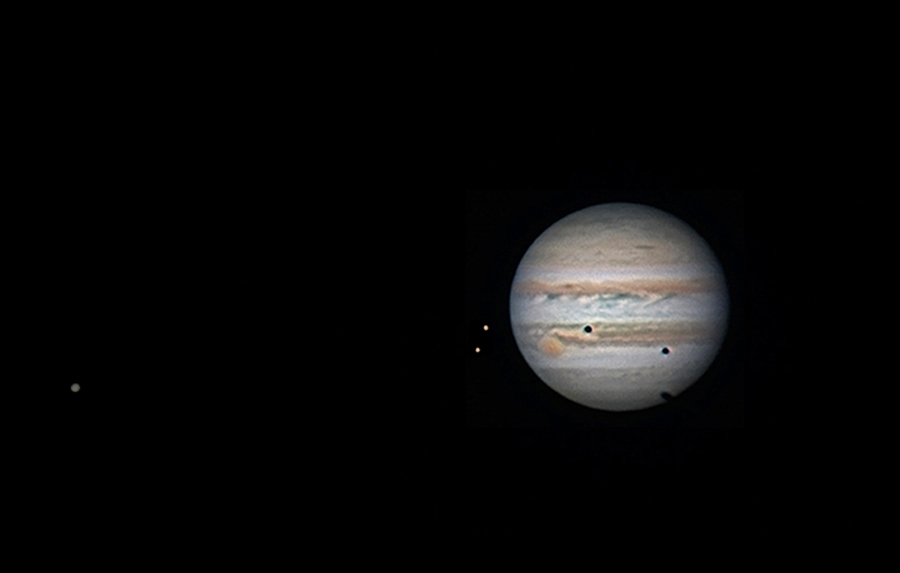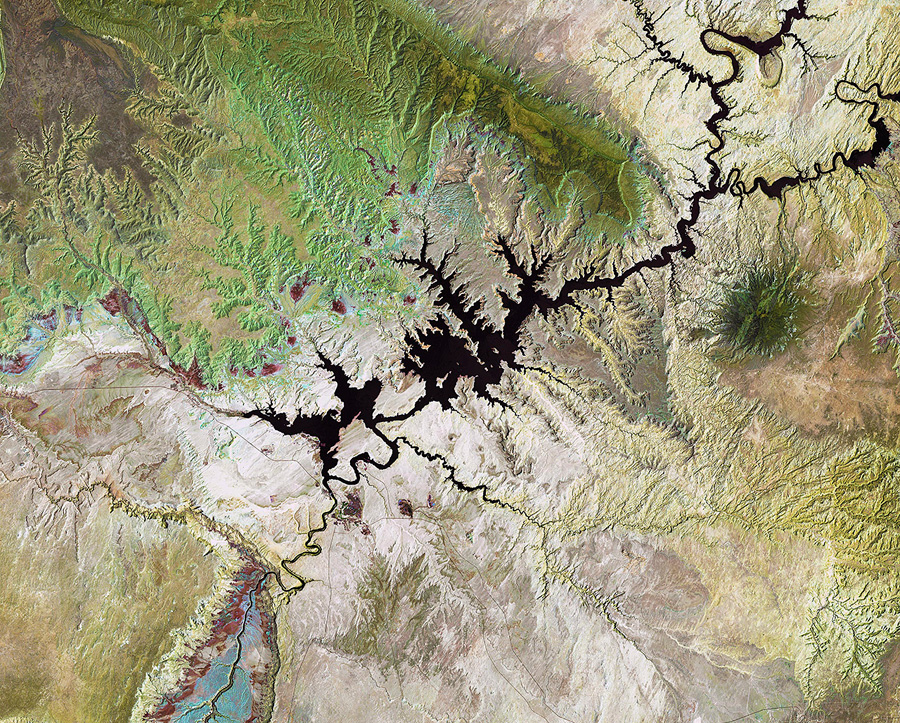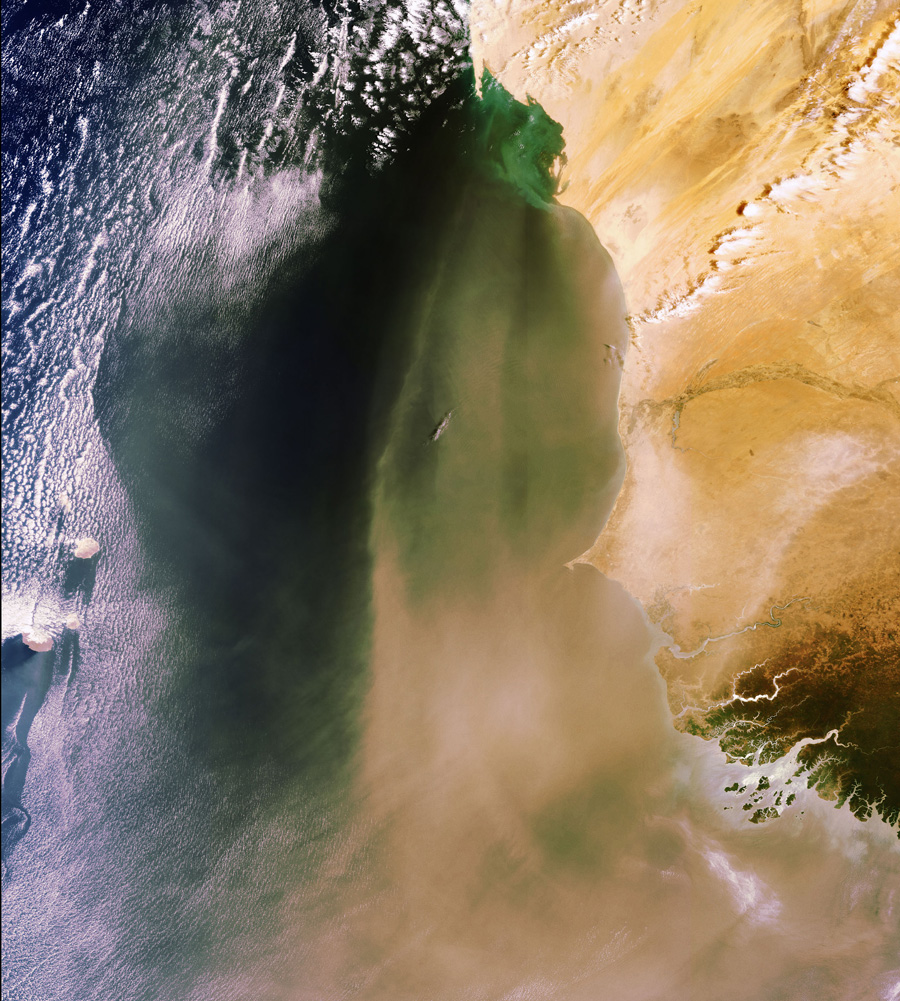
Antarctica from space
Amazing.
Giseli.ramosWhoa, não sabia disso!

Did a bunch of dogs breakup a fight between two cats? Am I seeing this right??
Having none of that shit today.
“Ay man, y’all chill the fuck out. Y’all fucking up the party.”
I CAN’T BELIEVE WHAT I’M SEEING
Pack animals like dogs don’t tolerate dissent in their group because it weakens the pack’s social structure… There are similar clips on youtube of them breaking up rabbit and rooster fights… They don’t care what species you are, they just want you to CUT THAT SHIT OUT.
They don’t differentiate species because dogs think everything else is just a weird dog.

Winter has crashed down upon us and settled in for a long stay, but that does not mean nature’s beauty has faded away. As you can see in this series of winter landscape photographs, nature plays no favorites with beauty. She is just as cunning of an artist with ice and snow as she is with green grass. flowers, and trees. She paints the trees with a dusting of frost. She creates icy mirrors from the still lakes to reflect the beauty of her creations. She creates sculptures with her icicles and snow drifts. She intermixes snow covered trees and ground with open waters filled with wild geese. She floats snow through the nighttime air creating twinkling flakes reflecting lights. Nature’s elegance stretches through the seasons. We are thrilled that some photographer dare the cold to capture some of nature’s most dramatic scenes.
Photo above by EarthPix

Photo by Lake Baikal

Photo by Hideyuki Katagiri

Photo by Marcin Ryczek

Photo by Kent Shiraishi

Photo by Jan Machata

Photo by Dmitry Dubikovskiy

Photo by Norbert Maier

Photo by deep21
 Photo by Friðþjófur M
Photo by Friðþjófur M

Photo by Lars van der Goor


Photo by Thomas Zakowski

Photo by Edwin van Nuil

Photo by Evgeni Dinev


Photo by Mark Geistweite

Photo by Emmanuel Coupe

Photo by Peter From
 Photo by oskarpall
Photo by oskarpall
Brené Brown is a professor at the University of Houston Graduate College of Social Work. She has dedicated her life to social work and studies vulnerability, courage, worthiness and shame.
Her fantastic 2010 TEDxHouston talk, The Power of Vulnerabilty, is one of the most popular TED talks with over 12 million views and led to Brown giving the final speech at a 2012 TED conference. That speech, Listening to Shame, is where the above quotes are taken from. Turns out Brown and I both love the same Teddy Roosevelt Man in the Arena quote. It’s literally the second quote I ever adapted into a comic (although it was posted as number 8) and remains one of my favourite quotes. In her speech, Brown tells of how that quote helped her during a difficult time amidst her own failures and setbacks (around the 12min mark). The fact that she references a quote I’ve already adapted in her own inspirational quote gave me the chance to get meta again and give a nod to my long-time readers who would recognise the first part of the comic.
RELATED COMICS: The Man in the Arena, Nature Loves Courage, The Fig Tree, Ultimate Self-Help Book.
- Brené Brown’s official website.
- Thanks to Mike, Saquib and Cynthia for sending me the TED talks.
A gente pode até rejeitar ser conhecidos por rótulos, clichês e caricaturas, mas elas até que possuem uma função. Permitem que tenhamos referenciais fáceis, formas simples e acessíveis de conhecer culturas, países e até pessoas. Claro que eles sempre são negativos quando usados com a finalidade de discriminar, diminuir ou segregar, porém, se usados para reconhecer mais rapidamente alguma riqueza, pode ser até interessante.
Acho que foi o caso desse infográfico. A imagem foi feita pela Wine Investment e cataloga bebidas típicas – não necessariamente alcoólicas – de 80 países pelo globo. Temos desde a nossa caipirinha, passando por absinto, saquê, mate, Coca Cola e até algumas que possuem nomes impronunciáveis.
Dá pra passar um tempo olhando os formatos dos copos e tentando identificar quais delas já se conhece.

Aqui eu separei alguns links contendo informações a respeito de cada uma delas. Infelizmente, nem todos me parecem confiáveis, em especial os links sobre bebidas da África – o que é uma pena.
Queria convidar vocês a me ajudarem a garimpar essas informações. Se encontrarem algum link com informações incorretas, me avisem e a gente vai montando um catálogo mais seguro.
Topam?

Back in April, orbiting observatories started picking up the first indications of a gamma-ray burst. By the time observations wrapped up, the event (GRB 130427A) produced the largest outpouring of photons of any yet detected, and it set a record for the highest energy photon we've seen from these events. And because it was unusually close to Earth, GRB 130427A provided a wealth of information about these extreme events—and told us that we don't really understand how they produce the gamma-rays that are their signature.
Yesterday's issue of Science contains four papers that describe the event, partly because it was unusually well-documented. The enormous stars that produce gamma-ray bursts were much more common in the early Universe and, as a result, most of them occur out at the edge of the observable Universe. But GRB 130427A is an exception; the Universe was already about 10 billion years old when it happened, meaning the supernova that produced the gamma rays occurred less than four billion light years from Earth. As a result, ground-based instruments that were directed to the right area of the sky by the orbiting instruments were quickly able to identify the supernova involved (SN 2013cq).
Meanwhile, the orbiting observatories like SWIFT and Fermi continued to track the event as it occurred. The data they gathered showed that GRB 130427A was an impressive event. At lower energies, it showed a characteristic initial burst followed by a pause of several seconds. The pause ended with a long and complex series of emissions that lasted for roughly 10 seconds, after which there was a gradual tailing off of activity. At the highest energies, however, there was a steady buzz of activity from five seconds out to at least 30, and gamma rays continued to be detected out to 20 hours, setting a record for these events

 Jupiter's Triple Shadow Transit
This webcam and telescope image of banded gas giant Jupiter
shows the transit of
three shadows cast
by Jupiter's moons in progress, captured in Belgian skies on
October 12 at 0528 UT.
Such a three shadow transit is a relatively
rare event,
even for a
large planet with many moons.
Visible in the frame are the three Galilean moons responsible,
Callisto at the far left edge,
Io closest to Jupiter's disk,
and Europa below and just left of Io.
Of their shadows on the
sunlit Jovian cloud tops,
Callisto casts the most elongated one near
the planet's south polar region at the bottom.
Io's shadow is above and right of Jupiter's Great Red Spot.
Of course viewed from Jupiter's perspective, these
shadow crossings could be seen as solar eclipses, analogous to the
Moon's shadow crossing
the sunlit face of planet Earth.
Jupiter's Triple Shadow Transit
This webcam and telescope image of banded gas giant Jupiter
shows the transit of
three shadows cast
by Jupiter's moons in progress, captured in Belgian skies on
October 12 at 0528 UT.
Such a three shadow transit is a relatively
rare event,
even for a
large planet with many moons.
Visible in the frame are the three Galilean moons responsible,
Callisto at the far left edge,
Io closest to Jupiter's disk,
and Europa below and just left of Io.
Of their shadows on the
sunlit Jovian cloud tops,
Callisto casts the most elongated one near
the planet's south polar region at the bottom.
Io's shadow is above and right of Jupiter's Great Red Spot.
Of course viewed from Jupiter's perspective, these
shadow crossings could be seen as solar eclipses, analogous to the
Moon's shadow crossing
the sunlit face of planet Earth.
“It is not when truth is dirty, but when it is shallow, that the lover of knowledge is reluctant to step into its waters.” -Friedrich Nietzsche
Although the innermost planets, from Mercury through Saturn, were known since ancient times, it’s only since the advent of the telescope that we’ve discovered what really lives in our Solar System. Over the past four centuries, the wonders of not only the distant Universe, but also our nearby neighborhood, have been uncovered in spectacular detail.
The third and fourth largest planets were discovered, as were a plethora of moons around other worlds, a belt of asteroids between Mars and Jupiter (at the ice-line of our Solar System, or where the strength of the Sun is insufficient to move water out of its solid phase), and a Kuiper belt out beyond the final planet. (And the Oort cloud even beyond that!)
Although Uranus was discovered in 1781 by William Herschel and its bizarre failure to adhere to Kepler’s laws led to the prediction-and-discovery of Neptune in 1846, it wasn’t until 1930 that a lone astronomer, looking at pairs of images taken at different times, happened upon the serendipitous discovery of a lifetime.
Even though it was the only world located out beyond the orbit of Neptune for nearly 50 years (until Pluto’s largest moon, Charon, was discovered), it was recognized relatively quickly that Pluto was a harbinger for many more such objects, now recognized (and confirmed, since 1992) to be just one of a great many located in the Kuiper Belt. The other bodies began to exhibit a variety of sizes, shapes, and orbital characteristics, although they all had a number of properties that threw Pluto’s “privileged” status as a “planet” into question:
This all came to a head in 2005, when it was discovered that Pluto isn’t even the most massive object in the Kuiper Belt!
That distinction belongs to Eris, which weighs in at about 127% the mass of Pluto. That discovery paved the way for a new classification scheme that included an additional class of Solar System objects known as dwarf planets, of which Eris and Pluto are the two most massive at the present time.
But when it comes to the King of all Kuiper Belt objects, none of these little monsters can stake that claim. Because there’s one object that we don’t normally think of as a Kuiper Belt object that has them all beat.
This is Neptune, the outermost planet in our Solar System. No, it doesn’t qualify as a Kuiper Belt object; it’s a planet, just like you’ve always learned. But back in 1846, there were some awfully powerful telescopes in the world, certainly much better and bigger ones than were around in 1781 (when Uranus was discovered) or at any time before that. Back in 1781, there was only one telescope in the world — commissioned in 1780 — that had a primary mirror of two feet (61 cm) or more in diameter.
By time 1846 came around, the largest telescope in the world had a primary mirror that was six feet (1.8 meters) in diameter, and amateurs with no formal training — like William Lassell — were building their own two foot diameter telescopes themselves.
The timetable for the discovery of Neptune was swift: Urbain Le Verrier announced his prediction for the undiscovered planet’s position on August 31, 1846, and composed a letter to Johann Galle, director of the Berlin observatory. Galle and his assistant, Heinrich d’Arrest, looked for the planet on September 23, and discovered it that very night in one of the greatest accomplishments of all-time in theoretical astrophysics.
But news traveled fast, and back in England, William Lassell was eager to view the newly-discovered world.
Just 17 days after the discovery of the hypothesized new world that had occupied many of the world’s greatest professional astronomers for decades, a virtually unknown and amateur telescope-maker discovered Triton, by far the largest satellite world of Neptune. (Although to be fair, it was the largest telescope in England at the time.) If all the Solar System’s moons were compared to one another, Triton would be the seventh largest in size, behind only Earth’s Moon, Saturn’s Titan, and the four Jovian moons discovered by Galileo.
But — up close — Triton doesn’t look like any other large moon in the entire Solar System! For one, every other large moon revolves around its planet the same way all the planets revolve around the Sun: counterclockwise, as viewed if you flew directly upwards above the Earth’s north pole. But not Triton, which revolves around Neptune in the opposite direction!
In terms of density, it resembles Pluto far more than it resembles either Neptune or any other Moon in the Solar System. And in terms of atmospheric composition, it’s virtually identical to the known worlds found in the Kuiper Belt.
What does all this mean?
That Triton isn’t a naturally occurring moon of Neptune, but has been gravitationally captured (by the same mechanism described here last week) from its place of origin: the Kuiper Belt. Even though it isn’t currently in the Kuiper Belt, that doesn’t stop it from being the largest, most massive, most accessible, first-discovered, and in many subjective ways, greatest Kuiper Belt Object of them all!
But it’s real, it’s spectacular, and unlike every other Kuiper Belt Object (so far), we’ve been there! That was thanks to Voyager 2 in 1989; take a look at this photo mosaic of a large chunk of its surface!
If it looks cantaloupe-like to you away from the poles, well done; that’s the semi-official NASA term for it! So the next time you think about worlds from beyond our planets, don’t just think of frozen ice-and-rock-balls orbiting in deep space, nor only of the comets disturbed by passing gravitational bodies and hurled inwards towards the Sun, but also of the rogue worlds that migrate inwards and wind up captured by gas giants.
After all, if you didn’t include them, you’d be missing out on Triton, largest of all the trans-Neptunian objects and the onetime King of the Kuiper Belt!

Sand Prints is a series of ephemeral art created by environmental artist Ahmad Nadalian. Each site-specific piece is a small sculpture naturally blended into a beach or desert landscape. The sculptures become a part of the surrounding land and provide viewers with the opportunity to explore, touch, and even disrupt the final images.
In all of his work, the artist redefines ancient rituals and symbols in contemporary ways. This project is inspired by an ancient printing technique that used carved cylinders to create repeating patterns. Nadalian's modern-day carvings include living creatures like fish, snakes, and crabs, as well as floral patterns that he rolls along the surface of the sand to produce the long rows of repetitive illustrations.
The beauty of each piece is that the loose earth can hold the designs for only so long before the wind disrupts the arrangement or the tide washes it away. Through this fleeting process, Nadalian believes he is making an offering to the Earth, hoping to heal the spirit of our neglected environment. He says, "Art offers a blessing and hope for harmony with the past, with the earth, and the heavens."
"History being a branch of the biological sciences, its ultimate expression must be mathematical."

Anna Anthropy's site Annarchive is a semi-permanent collection of game media, archaeology, and artifacts…collected from illicit websites.
Last month she posted a huge collection of 1983-1993 MS-DOS Shareware games she acquired from Jeremy Penner of Glorious Trainwrecks fame. Shareware software/games are usually limited demos that require purchase to unlock full functionality, and for a while, these games were distributed on floppies and en masse on CD-Roms.
Well, you can now download these MS-DOS shareware games and fire up your old PC or run the DosBox emulator to give them a shot. Exciting. Relive an earlier era of videogame history.-LT
A OCP Cyberdine Boston Dynamics é uma daquelas empresas que está trabalhando a sério para garantir o Apocalipse Robótico. O mais engraçado é que mesmo sabendo disso, mesmo sendo mais que escolados nas consequências de escravizar máquinas que eventualmente se tornarão inteligentes, continuamos achando um barato.
Confesso, há uma esperança de que façamos a coisa certa e mantenhamos o nível de inteligência de nossas máquinas equivalente ao de animais espongiformes e comentaristas de YouTube, assim elas serão úteis mas não ameaçadoras. Só que, sendo realista, o uso primário será militar, e soldados burros só são úteis em discurso pacifista de hippies liberais.
Uma das demonstrações de inteligência é saber se adaptar ao ambiente, e a Boston Dynamics está fazendo isso direitinho. Um dos últimos robôs deles, o WildCat, consegue correr a 40 km/h, e quando cai, levanta e continua. Imagine um bicho desses atrás de você. Com lasers.
O Cheetah só correu em laboratório. É um robô que atingiu 60 km/h. Aquele tigre dos transformers não parece tão ficção assim, né?
O robô mais avançado, o Atlas, aprendeu a andar em terreno irregular, cheio de pedras. Se esconder nas colinas não adiantará mais. Pior: como fica claro no minuto final do vídeo, o Atlas está aprendendo a lutar Karatê. Estamos mortos.
A cereja do bolo apocalíptico é o Petman, o robô anterior ao Atlas, aqui visto usando roupas. A humanidade de seus movimentos é perturbadora. Você eu não sei mas se minha vizinha se chamasse Sarah Connor eu me mudaria na hora.
Fonte: SH.
The post Boston Dynamics demonstra outro robô, e desta vez não adianta correr pras montanhas appeared first on Meio Bit.
 The icy waters of the Baltic Sea surrounding Germany’s largest island, Rügen, JAXA/ESA
The icy waters of the Baltic Sea surrounding Germany’s largest island, Rügen, JAXA/ESA
 A phytoplankton bloom swirls a figure-of-8 in the South Atlantic Ocean about 600 km east of the Falkland Islands. Different types and quantities of phytoplankton exhibit different colours, such as the blues and greens in this image, ESA
A phytoplankton bloom swirls a figure-of-8 in the South Atlantic Ocean about 600 km east of the Falkland Islands. Different types and quantities of phytoplankton exhibit different colours, such as the blues and greens in this image, ESA
 The landscape of the Tanezrouft Basin, one of the most desolate parts of the Sahara desert, in south-central Algeria. The region is known as ‘land of terror’ because of its lack of water and vegetation, JAXA/ESA
The landscape of the Tanezrouft Basin, one of the most desolate parts of the Sahara desert, in south-central Algeria. The region is known as ‘land of terror’ because of its lack of water and vegetation, JAXA/ESA
 The southern Atacama Desert, with the border of Chile (west) and Argentina (east) running down the middle. The Atacama is believed to be the driest desert in the world, and the lack of cloud cover in this image highlights the dry climate, ESA
The southern Atacama Desert, with the border of Chile (west) and Argentina (east) running down the middle. The Atacama is believed to be the driest desert in the world, and the lack of cloud cover in this image highlights the dry climate, ESA
 Beijing, NASA/ESA
Beijing, NASA/ESA
 Clearwater Lakes, located to the east of the Hudson Bay, what appears to be two separate lakes is actually a single body of water that fills two depressions. The depressions were created by two meteorite impacts, believed to have hit Earth simultaneously up to 290 million years ago, USGS/ESA
Clearwater Lakes, located to the east of the Hudson Bay, what appears to be two separate lakes is actually a single body of water that fills two depressions. The depressions were created by two meteorite impacts, believed to have hit Earth simultaneously up to 290 million years ago, USGS/ESA
 The northern part of the country of Namibia. Namibia is located on the west coast of southern Africa between Angola and South Africa, ESA
The northern part of the country of Namibia. Namibia is located on the west coast of southern Africa between Angola and South Africa, ESA
 Lake Powell, USGS/ESA
Lake Powell, USGS/ESA
 In this false-color image of the Mississippi River delta, land vegetation appears pink, while the sediment in the surrounding waters are bright blue and green, USGS/ESA
In this false-color image of the Mississippi River delta, land vegetation appears pink, while the sediment in the surrounding waters are bright blue and green, USGS/ESA
 The sand seas of the Namib Desert, KARI/ESA
The sand seas of the Namib Desert, KARI/ESA
 The Paraná River cuts through this image of southern Brazil, ESA
The Paraná River cuts through this image of southern Brazil, ESA
 The northern end of the Persian Gulf, along with the border of Iran and Iraq and the mouth of the Shatt al-Arab river, USGS/ESA
The northern end of the Persian Gulf, along with the border of Iran and Iraq and the mouth of the Shatt al-Arab river, USGS/ESA
 Sand and dust blowing northeast from the Arabian Peninsula across the Persian Gulf toward Iran (visible at image top), ESA
Sand and dust blowing northeast from the Arabian Peninsula across the Persian Gulf toward Iran (visible at image top), ESA
 The foothills of the Andes mountains near the southern coast of Peru, KARI/ESA
The foothills of the Andes mountains near the southern coast of Peru, KARI/ESA
 Sand and dust from the Sahara Desert blowing across the Atlantic Ocean along the coasts of Mauritania (top), Senegal (middle) and Guinea Bissau (bottom), ESA
Sand and dust from the Sahara Desert blowing across the Atlantic Ocean along the coasts of Mauritania (top), Senegal (middle) and Guinea Bissau (bottom), ESA
 North central Siberia, ESA
North central Siberia, ESA
 Three of the five Great Lakes of North America. Lakes Huron (left) and Erie (bottom) are partially ice-covered following snow storms in Michigan and Cleveland, while Lake Ontario (right) is completely visible in blue, ESA
Three of the five Great Lakes of North America. Lakes Huron (left) and Erie (bottom) are partially ice-covered following snow storms in Michigan and Cleveland, while Lake Ontario (right) is completely visible in blue, ESA
 Running across the image, the Okavango River forms the border between Namibia to the south and Angola to the north, KARI/ESA
Running across the image, the Okavango River forms the border between Namibia to the south and Angola to the north, KARI/ESA
 Rolling hills of farmland in part of the Palouse Region in the northwest United States, KARI/ESA
Rolling hills of farmland in part of the Palouse Region in the northwest United States, KARI/ESA
 The Tibesti Mountains, located mostly in Chad with the northern slopes extending into Libya, ESA
More photographs of Earth
Atley
The Tibesti Mountains, located mostly in Chad with the northern slopes extending into Libya, ESA
More photographs of Earth
Atley
image via Rizzoli International Publications
Codex Seraphinianus is a surreal encyclopedia that documents an imaginary world populated by fanciful flora and fauna. The book is the work of Italian artist Luigi Serafini, who created its fantastic illustrations and filled its pages with handwritten text in a mysterious invented language. Codex Seraphinianus was originally published in 1981 and has been reprinted several times—the latest edition will be available on October 29, 2013. For more on Serafini and his mysterious book, check out this Dangerous Minds post.
photo via Dangerous Minds
photo via Dangerous Minds
via Dangerous Minds

The Game of Life
Select the difficulty level: Easy (Fácil) / Normal / Hard (Difícil)